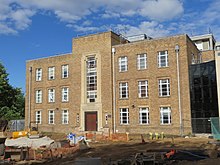Clarendon Laboratory
The Clarendon Laboratory is a traditional physics laboratory at Oxford University . It is located in the Oxford Science Area.
The Clarendon Laboratory is named after the foundation for the first building, which opened in 1872. The foundation from the estate of Edward Hyde financed the construction with 10,000 pounds at the time. The geosciences department is now located in the original building. It was the first purpose-built physics laboratory building in the UK, a building full of dark little rooms, winding corridors and unexpected corners . The Cavendish Laboratory in Cambridge did not open until a year after the Clarendon Laboratory in 1873. In 1939 the old building was given up and the physicists moved into a new building.
The first director for almost fifty years until his retirement in 1915 was Robert Bellamy Clifton , who from 1865 was Professor of Experimental Physics at Oxford. Clifton put little emphasis on research funding. After all, he allowed Charles Boy's measurements of the gravitational constant, which he was unable to carry out because of the ubiquitous disturbing vibrations in London. In 1910 the Electrical Laboratory was founded for the second professor of experimental physics, John Sealy Townsend . After Clifton, Frederick Lindemann (Lord Cherwell) was director from 1919 , who led the laboratory from a state of decline under Clifton to one of the leading physics institutes in the country and greatly expanded it.
Henry Moseley , who was at Clarendon from 1913 but died in World War I in 1915, and the brothers Fritz London and Heinz London and the low-temperature physicist Kurt Mendelssohn as well as the atomic physicist Derek worked here, among others , during the Lindemann era, who set up a center for low-temperature physics Jackson and Heinrich Gerhard Kuhn . During the Second World War, the focus was on radar research and many of the scientists went to the British atomic bomb project and the Manhattan project in the USA. After the war, research on microwave technology (radar) at Clarendon was applied to solid state physics and atomic physics ( EPR , NMR ). In 1957 Brebis Bleaney became director ( Francis Simon was initially scheduled, but died before that). Laser spectroscopy was expanded in the 1970s. From 1977 to 1987 EWJ Mitchell (Bill Mitchell) was director and from 1988 RA Cowley .
The laboratory building now houses the atomic physics, laser physics, condensed matter physics and biophysics departments of the Oxford Physics Faculty and the Oxford Center for Quantum Computation.
In 2007 it received Chemical Landmark Status for the work done by Moseley.
Web links
Individual evidence
- ^ Oxford History, Inscriptions .
- ^ Faculty website on the history of physics at Oxford
- ^ Clarendon Laboratory, University of Oxford. Royal Society of Chemistry, September 24, 2007, archived from the original December 4, 2008 ; accessed on June 21, 2016 .
